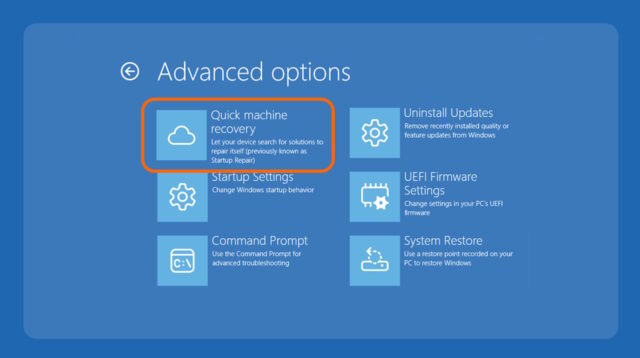Microsoft launches Quick Machine Recovery to automatically fix your Windows 11 problems

When things go wrong with a Windows 11 device, downtime is not only frustrating but also expensive. In a bid to reduce the time lost to computer issues, Microsoft has launched Quick Machine Recovery, a new automated tool for addressing problems.
The tool is undergoing testing with Windows Insiders on the Beta Channel at the moment, so it probably won’t be long before it is promoted for general availability. Billed as a tool that “automatically detects, diagnoses, and resolves critical issues on your device”, Microsoft is looking to save users and sysadmins from having to delve into the Windows Recovery Environment.
See also:
- Microsoft launches new Windows 11 roadmap page so you can see what it has planned for the operating system
- Microsoft is introducing Startup Boost to speed up Office applications like Word and Excel
- Microsoft accounts now have a sleek new sign in experience with a dark mode option
Illustrating how the new feature is designed to take the hard work out of fixing problems, Microsoft says that the tool will eventually be enabled by default for Windows 11 Home devices. But the aim is also to reduce the workload of IT departments, making it possible to have issues addressed automatically.
The company explains:
With quick machine recovery, when a widespread outage affects devices from starting properly, Microsoft can broadly deploy targeted remediations to affected devices via Windows RE—automating fixes and quickly getting users to a productive state without requiring complex manual intervention.
So how does the recovery process look? In the event of a widespread outage, there following occurs:
- Device enters recovery mode: If a Windows 11, version 24H2 device encounters a critical failure preventing normal boot, it enters Windows RE.
- Network connection established: Windows RE connects to the network using ethernet or Wi-Fi protected access (WPA), ensuring the device can communicate with Microsoft's recovery services. Future updates will introduce additional networking configurations for broader support.
- Incident analysis: Microsoft analyzes crash data from affected devices to identify patterns and pinpoint the root cause. If a widespread outage is detected, an internal response team is activated to develop, validate, and prepare a targeted remediation.
- Remediation rollout: In this initial release, Microsoft will deliver the remediation via Windows Update, adhering to the update policies configured on the device. Microsoft will safely rollout the remediation.
Microsoft shares some details about the new tool in a blog post:
Quick machine recovery (QMR), part of the Windows Resiliency Initiative announced at Ignite 2024 is now available in the latest Windows Insider Preview build. This feature, when enabled, addresses widespread boot issues on Windows 11 devices by automatically detecting and applying fixes directly from the Windows Recovery Environment (WinRE) thereby reducing the system downtime and manual intervention. When a critical boot failure occurs, the device enters WinRE, connects to the network, and sends diagnostic data to Microsoft, which can then deploy targeted remediations via Windows Update. IT admins are encouraged to enable, customize, or test this feature, which is enabled by default for home users. Windows Insiders can start testing it today and provide feedback via Feedback Hub to refine the feature further. In the Feedback Hub app on your Windows device, select Recovery and Uninstall > Quick Machine Recovery. Keep an eye out for a test remediation package coming your way in the next few days, allowing you to experience the quick machine recovery in action.
The ability to disable Quick Machine Recovery will be important for many users, but Microsoft is clearly hoping that the tool will be well-received. The initial release has a handful of features, including a simulation mode to test out the recovery process before committing.

Pingback: Microsoft is giving the Windows 11 Start menu a major overhaul — and you’re going to love it! - The TechBriefs
Pingback: Microsoft's Quick Machine Recovery Tool will automatically fix boot failures on Windows 11